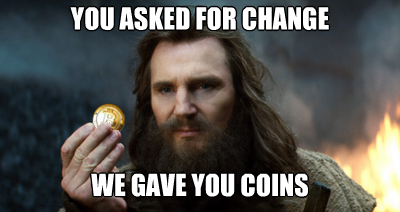
Hello everyone! Long time, no steem.
Speaking of cheesy, suppose my neighbor's a dairy farmer and I want a block of his finest cheddar cheese. So I propose to him that I can give him something of mine in return for a block of cheese. There's a roadblock here: how do we reach a consensus on the relative values of our products?
Say that I make the best damn fidget spinners around and I value a block of cheese at 10 of my fidget spinners. If I was (WAS) a cheese addict, I would be happy to pay 69 fidget spinners. I bring him a box of my FDA-approved high-performance spinners and he says, "What the hell are these? I don't see how these could equate to a block of cheese in any way possible. Give me something else." Then I ask him what he would want instead and he supposes he would trade me a block for a pair of Lightning McQueen Crocs. I don't see how those could equate to a block of cheese in any way possible, so the deal is off.
Individuals naturally have different tastes, preferences, and evaluations of substance. Without introducing a medium that can map the value of a product to a countable and discrete measure of value, relative interests are prone to linear misalignment: in comes the concept of a universal measure, a currency.
Now in a case involving a currency, both the dairy farmer and I can reach a consensus on the worth of his block of cheddar in terms of the currency. The deal could still not happen, but at least now there's a mechanism to facilitate consensus.
A logical followup question could be: "How do we determine that universal amount of worth for these products in the first place?" This can be done a couple of ways: via a valuation of the enthusiasm and trust that the users of a currency have in it, and/or via the valuation of a universally valued product. Either way, the problem being addressed is finding a basis for substance to value and value to substance. In other terms, [commodity -> currency -> commodity -> ...] is a basis for assessing the value of a product.
Let's think now about the cryptocurrency environment. Some coins, like GridCoin, FoldingCoin, Einsteinium, etc., get their value from work performed on tangible scientific research and development and other causes that cast a real-world projection outside of the coin's own presence. Most coins, however, derive their value from more internal and self-serving properties like a focus on transaction anonymity, fast block times, network hashrate, method of network consensus, etc. And yet, nothing prevents these different coins from being exchangeable.
I believe that cryptocurrencies have become such a force in these recent years because of our developing enthusiasm, valuation, and trust in their purpose and delivery. We now are more than ever placing a higher value on not just the cost-derived value of the work required to maintain and perpetuate a given coin network, but also on the ideas and intrinsic functions a given coin operates with respect to. Cryptocurrencies have become a true superposition of commodity and currency, where [commodity <--> currency]. All of these developments have and will continue to come about through greater understanding and experimentation.
What do you all think? Comment below!

It's a strange thing that people always want "value" in their medium of exchange. In a perfect world, the transaction would occur with an item of no value other than the reflection of the two buyers value of commodities being traded.
This would prevent people from hoarding mediums of exchange and taking them out of circulation. Greed is truly the root of the problems that exist in finance. Unfortunately there is always somebody that would rather just collect the medium whether it be bitcoins or gold or cash... regardless of the fact that the long term value may be 0 (as in cash).
I don't think it's too strange... just a little. If you think about it, a medium of no determined value sounds like a fiat currency, where the medium is basically an IOU. Since they have no inherent backing of value, they're subject to radical fluctuations in price and supply, whereas a medium with some barrier to creation and ownership is in most cases more resistant to forces like that.